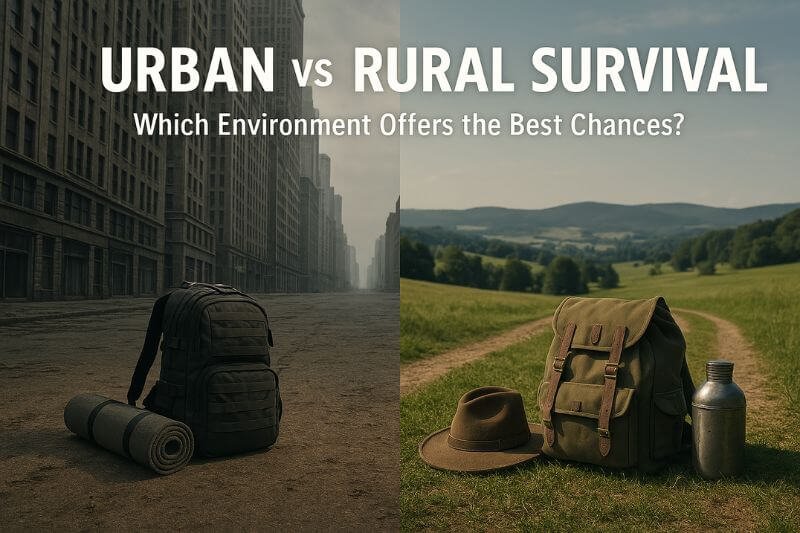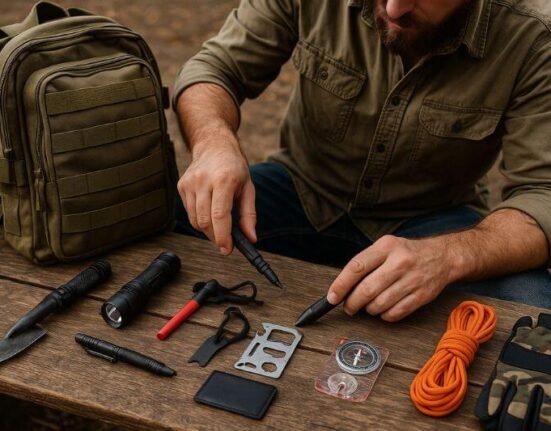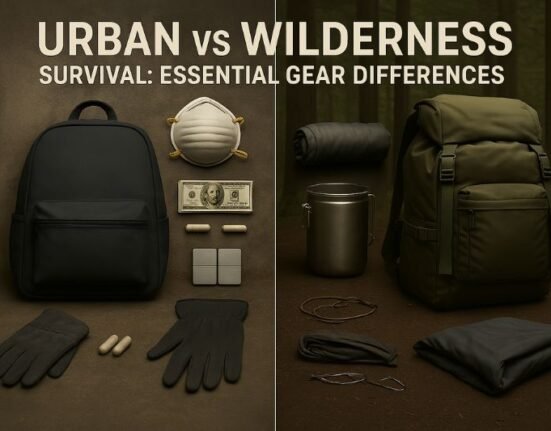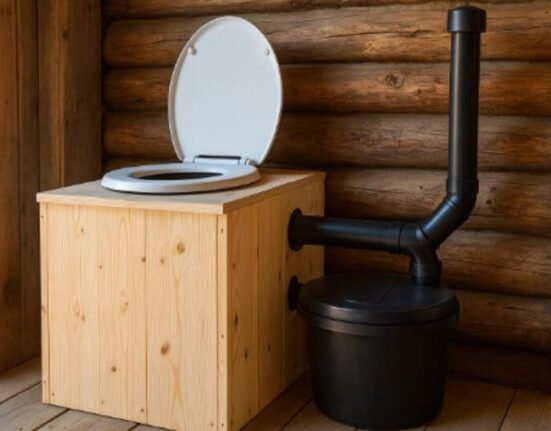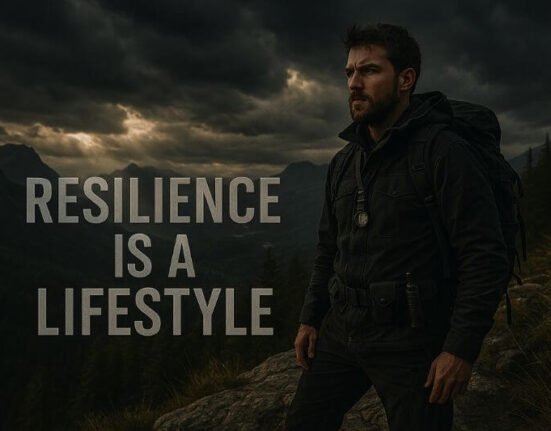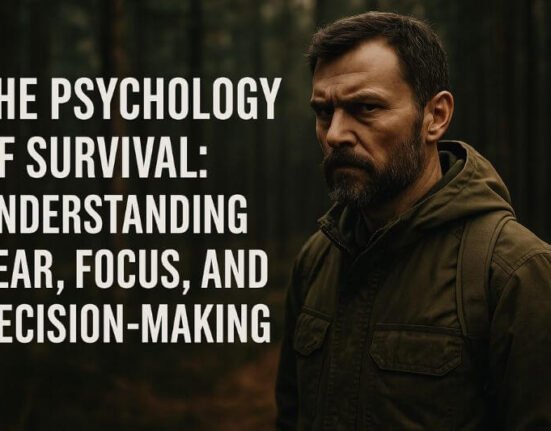When collapse strikes, where you are can be as critical as what you know.
In a survival scenario, choosing between the chaos of a collapsing city and the isolation of the countryside isn’t just theory—it’s a life-or-death reality.
Both environments offer survival advantages. Both hide lethal risks.
And if you’re not prepared for the unique challenges of your terrain, no amount of gear or training will save you.
In this guide, we’ll break down the hard truths about urban and rural survival: where you’ll find resources, where danger moves fastest, and where you stand the best chance of enduring when the system falls apart.
Because survival isn’t about where you wish you were—it’s about adapting to where you are.
🧭 Part 1: Understanding the Urban vs Rural Survival Dilemma
When it comes to urban vs rural survival, one of the most debated questions in the prepper community is simple: Where are you more likely to survive a full-blown crisis—within the chaos of a collapsing city or deep in the isolation of the countryside?
Both environments offer unique advantages and unforgiving drawbacks. And in real-world scenarios—whether it’s civil unrest, grid failure, or a full-scale societal collapse—your environment can either save you or get you killed.
🏙️ The Urban Survival Landscape: Concrete and Chaos
Urban environments are home to over 55% of the global population, and that number is rising. When a major event hits—think pandemic, EMP, mass rioting—cities become flashpoints. But they also come with surprising advantages.
✅ Urban Survival Pros
- Immediate access to resources: Abandoned stores, apartments, warehouses can provide food, water, tools.
- Medical infrastructure: Hospitals (even if understaffed) are closer than in remote areas.
- Hidden networks: Underground shelters, storm drains, subways offer tactical advantages.
❌ Urban Survival Cons
- Overpopulation: Desperation breeds violence. The higher the population density, the faster things spiral out of control.
- Looting and gang activity: FEMA and DHS data show that within 72 hours of infrastructure failure, crime rates in dense areas spike up to 300%.
- Dependency on systems: Most urbanites rely entirely on electricity, water treatment, public transport, and food delivery chains.
🧠 Real-World Example
In the 2005 Hurricane Katrina aftermath, urban New Orleans descended into chaos in less than 48 hours. Hospitals were overwhelmed. Supermarkets emptied in hours. And those who couldn’t evacuate were left fighting for basic supplies.
🌄 The Rural Survival Landscape: Isolation and Independence
In contrast, rural survival leans heavily into the values of self-reliance, community bonding, and distance from the madness. But distance can also mean delay—especially when you need help fast.
✅ Rural Survival Pros
- Self-sufficiency: Gardens, livestock, wells—everything you need to thrive without a system.
- Lower threat of looting: Smaller populations mean fewer confrontations.
- Stronger community ties: Neighbors often cooperate for mutual aid, rather than compete for resources.
❌ Rural Survival Cons
- Delayed emergency response: In a medical crisis or fire, response times can be fatal.
- Vulnerable to isolation: Cut-off roads, fallen trees, or lack of communication lines can isolate you completely.
- Harder resupply: No local pharmacy or hardware store when things run out.
🧠 Real-World Example
During the 2021 Texas ice storm, rural families with wood-burning stoves and food stores fared far better than their urban counterparts who were trapped in apartment buildings with no heat or running water.
⚖️ Urban vs Rural: Critical Comparison Table
| Category | Urban Survival | Rural Survival |
|---|---|---|
| Resource Availability | High (initially) | Medium (but renewable) |
| Violence Risk | High | Low to Medium |
| Medical Access | Better facilities | Poor access, longer response time |
| Self-Sufficiency | Difficult without prior prepping | Easier with land, tools, and knowledge |
| Community Dynamics | Competitive, often hostile | Cooperative, tight-knit |
| Escape Routes | Limited, traffic-clogged | Open, flexible |
| Learning Curve | Steep if unprepared | Requires rural skills and setup upfront |
📋 Quick Visual Checklist: Key Risks by Environment
🔴 Urban Risk Checklist
- Looting/gang violence
- Fuel and food shortage
- Infrastructure failure (water, electricity, comms)
- Medical facility overload
- Martial law or lockdowns
🟢 Rural Risk Checklist
- Long distance to medical help
- Fuel/transportation constraints
- Road blockages (natural or human-made)
- Lack of immediate backup or defense help
- Communication dead zones
📣 What the Experts Say
“In a widespread disaster, urban areas become risk multipliers. Without immediate evacuation, survival comes down to improvisation and aggression.”
— James Rawles, survival expert and founder of SurvivalBlog
“Rural living provides a long-term edge, but only for those who have planned years in advance—with tools, skills, and a strong support network.”
— FEMA Crisis Response Handbook, 2022
🔄 Adaptability: The Most Crucial Survival Skill
Whether you’re in the heart of a city or miles from the nearest neighbor, survivability isn’t just about location—it’s about adaptation.
Urban preppers who know how to blend in, avoid confrontation, and scavenge effectively can outlast many. Meanwhile, rural dwellers without backup power, water filtration, or security training can find themselves exposed when things go sideways.
You’re not just choosing a place. You’re choosing a set of survival dynamics that need to be trained for and planned around.
🔪 Part 2: Tactical Survival Strategies for Urban and Rural Environments
Choosing between urban and rural survival isn’t just about where you are—it’s about how well you prepare, adapt, and act within that space. The same crisis plays out very differently in a city than it does in the countryside. Let’s break down the tactics that work, and just as importantly, the ones that don’t.
🧰 Urban Survival: Strategies When the Grid Goes Down
Urban survival is fast, dirty, and unpredictable. When the grid fails or the population panics, the first 72 hours are the most dangerous.
🛠️ Key Urban Survival Tactics
- Grey man strategy
- Avoid drawing attention. No flashy gear, no talking about your supplies. Blend in and move silently.
- Fast bug-out plan
- Know at least three routes out of the city: one on foot, one by bike, one by car.
- Urban scavenging
- Learn how to identify overlooked resources: vending machines, office buildings, construction sites.
- Apartment defense
- Reinforce entry points, use blackout curtains, and maintain noise/light discipline at night.
📦 Urban Bug-Out Bag Essentials
| Item | Why It Matters in Urban Survival |
|---|---|
| Respirator mask (N95+) | Protection from smoke, dust, tear gas |
| Crowbar or pry tool | Gaining access to resources/buildings |
| Compact bolt cutters | Removing urban barriers |
| Urban maps (offline) | Avoid GPS reliance |
| Noise-canceling earbuds | Reduce stress from chaos around you |
“In urban chaos, information is as vital as food—knowing which streets are blocked or where fires are spreading can mean the difference between life and death.”
— RedTeam Security, 2023 Urban Crisis Report
🚫 Urban Mistakes That Can Kill
- ❌ Staying too long: Hoping things will stabilize. Delayed evacuation can be fatal.
- ❌ Over-reliance on tech: Phones and apps fail. Paper maps and analog tools save lives.
- ❌ Poor opsec: Posting on social media or talking about your preps attracts looters.
- ❌ Overburdened bug-out bags: Speed > comfort. Drop the luxury gear, carry only what you need to move fast and stay alive.
🌾 Rural Survival: Living Off the Grid and Thriving
Rural prepping is about long-term sustainability. Here, you’re less likely to face riots or theft—but more likely to face logistical, medical, and environmental challenges.
🛠️ Key Rural Survival Tactics
- Water independence
- Drill a well, use gravity-fed systems, store backup filtration.
- Food security
- Prioritize perennial crops, root vegetables, and small livestock (chickens, rabbits).
- Perimeter defense
- Use natural barriers, motion sensors, and dogs. Avoid “fortress mentality”—discreet is better than obvious.
- Community alliances
- Trade goods and skills with neighbors. Set up radios, barter networks, and local watch systems.
📦 Rural Survival Supply Checklist
- Solar generator or battery bank
- Chainsaw and fuel (for firewood, clearing roads)
- Livestock feed (6+ months reserve)
- Large water containers (IBC tanks, barrels)
- Antibiotics and trauma kits (delayed EMS support)
“The success of rural survival depends more on preparation before a crisis than reaction after it starts.”
— CDC Preparedness Journal, Rural Resilience Issue 2020
🚫 Rural Mistakes That Can Kill
- ❌ Assuming isolation is safety: You may be the only target—easier to rob or manipulate.
- ❌ Overconfidence in homesteading skills: Gardening and animal care take years to master.
- ❌ Underestimating group threats: Desperate outsiders may target isolated homes.
- ❌ No communication backup: Cell towers fail. Learn HAM radio or mesh networks.
⚙️ Urban vs Rural: Strategic Comparison
| Strategy Type | Urban Survival | Rural Survival |
|---|---|---|
| Water Access | Scavenged (risky) or bottled | Wells, rain catchment, filtration systems |
| Energy Source | Grid-dependent or solar kits | Off-grid systems, fuel stockpiles |
| Food Source | Looted or bartered | Grown, raised, preserved |
| Escape Possibility | Limited, dangerous routes | Multiple, open terrain |
| Security Approach | Concealment, passive defense | Visibility, layered deterrence |
| Long-Term Viability | Low unless highly prepared | High if systems and skills are in place |
🔄 Hybrid Strategy: The Best of Both Worlds?
Some preppers adopt a dual strategy: living in a rural bug-out location, but working or staying urban part-time. Others hide caches in both areas. The key is flexibility.
“If you’re not locked into one environment—don’t be. Urban vs rural survival is not a binary choice. It’s a spectrum of risk, resource, and readiness.”
— Joe Alton, MD – Doom and Bloom Medical Prepper Series
🔗 Internal Link Suggestions
- Bug Out Bag Essentials: What You Actually Need vs. Useless Gear
- Long-Term Survival Supplies List: 90 Days Off-Grid Preparedness
- Family Bug Out Strategy: How to Prepare With Kids and Elderly
🔗 External DoFollow Links
🧭 Part 3: Choosing Your Survival Environment – Critical Factors and Final Verdict
Now that we’ve explored the dynamics and strategies of urban vs rural survival, one question remains: Which environment should you bet your life on when the system collapses?
The truth is, survival isn’t about the ideal—it’s about what you can realistically prepare for, based on your current skills, location, resources, and network. This final section helps you assess those elements and make a strategic decision.
🧮 The Decision-Making Framework
To choose your ideal survival environment, run your personal situation through this simple but effective 4-P Survival Matrix:
| Factor | Questions to Ask Yourself | Urban Bias | Rural Bias |
|---|---|---|---|
| People | Do I have a reliable local network? | ✅ Community | ✅ Isolation |
| Place | Do I control my shelter? Can I defend it? | ❌ Rent trap | ✅ Owned land |
| Preps | Can I store, rotate, and protect my gear? | ⚠️ Limited | ✅ Large space |
| Proficiency | Do I have the right survival skills for this area? | ⚠️ Scavenger | ✅ Homesteader |
“The best place to survive isn’t where you wish you were—it’s where you’ve already laid the groundwork.”
— Selco Begovic, urban warfare survivor, Balkan War
🧠 Psychological Survival: The Human Factor
Survival isn’t just about tools and tactics. It’s about mental toughness, adaptability, and emotional resilience.
Urban Stressors
- Constant noise, smoke, and aggression
- Lack of privacy
- Risk of betrayal or confrontation
Rural Stressors
- Isolation and boredom
- High workload (farming, maintenance)
- Emotional toll of being cut off from loved ones
According to a 2023 WHO report, depression and trauma-related conditions rise significantly in both environments after large-scale disasters. However, strong social ties (even in small communities) correlate with higher survival rates and better recovery outcomes.
🔥 Personal Scenario Examples
Let’s put this into concrete scenarios based on different types of individuals. Which one resembles you?
🔹 Profile 1: The Apartment Prepper (Urban)
- Lives in a dense city
- Knows the streets, subway routes
- Stores food and water in hidden compartments
- Ready to bug out in 10 minutes
✅ Best Strategy: Short-term urban survival followed by a planned bug-out to a rural retreat
⚠️ Risk: Delayed evacuation, overwhelmed hospitals, civil unrest
🔹 Profile 2: The Homestead Warrior (Rural)
- Owns a small farm 30 minutes from the nearest town
- Grows food, raises chickens, owns weapons
- Part of a barter/trade group in the county
✅ Best Strategy: Shelter-in-place long-term survival
⚠️ Risk: Medical emergencies, isolation, perimeter breaches
🔹 Profile 3: The Commuter Hybrid
- Lives suburban, works in the city
- Has a rural bug-out location 2 hours away
- Family trained in emergency protocols
✅ Best Strategy: Flexible relocation and asset caching
⚠️ Risk: Timing—too early is wasteful, too late is deadly
🧱 Infrastructure Collapse: What Happens Where?
| Collapse Type | Urban Impact | Rural Impact |
|---|---|---|
| Power Grid Failure | Total shutdown, elevators, ATMs, traffic | Minimal if off-grid |
| Water Treatment Failure | Immediate contamination, disease | Wells may remain usable |
| Gas/Fuel Shortage | Supply chain collapse, panic buying | Stockpiles, but risk of theft |
| Martial Law | Likely enforcement in city centers | Delayed or light presence |
| Food Shortages | Supermarkets looted in hours | Local farms & pantries extend window |
🧷 Source: Department of Homeland Security, Civil Contingency Planning Report 2023
✅ The Final Verdict: Which Offers the Best Survival Odds?
There’s no one-size-fits-all answer. But we can draw clear conclusions:
🏙️ Choose Urban Survival If:
- You can’t relocate
- You’re trained in urban tactics (stealth, negotiation, rapid movement)
- You have early warning systems and a clear bug-out plan
🌄 Choose Rural Survival If:
- You already live on/own land with resources
- You’ve built up infrastructure (water, power, food)
- You’re integrated into a local, resilient community
“Survival is not about escape. It’s about positioning yourself before the storm, not during it.”
— Jack Spirko, The Survival Podcast
🏁 Conclusion: Your Survival Mindset is the Real Weapon
Whether you choose urban streets or rural fields, remember: your mindset, planning, and community are what determine your survival—not the location alone.
Start now:
- Build your skillset
- Connect with local allies
- Assess your environment’s weak points
- Prepare layered plans for both staying and bugging out
You don’t rise to the occasion—you fall to your level of preparation.
❓ FAQ – Urban vs Rural Survival
Q1: Can I survive long-term in a city during a societal collapse?
Short Answer: Only with advanced prep and exit plans. Food, water, and safety will degrade rapidly.
Expanded Answer:
Yes, long-term survival in an urban setting is possible, but only for those who have prepared long before the collapse occurs. The key components include:
- A discreet food and water cache, well-hidden from looters.
- Mastery of the grey man strategy to avoid detection.
- Knowledge of evacuation routes, alternate safehouses, and timing.
- Community alliances with neighbors you trust—or complete independence if you can’t.
However, no matter how well-prepared you are, urban environments are not sustainable for the long haul. After 30–60 days, supplies will dwindle, disease may spread, and violence often increases. Even seasoned preppers like Selco Begovic, who survived the Balkan urban collapse, emphasize:
“Your goal in a city isn’t to survive forever. It’s to survive long enough to leave.”
If you’re staying put in a city, focus on stealth, efficiency, and quick decision-making. But your endgame should always include an escape—either to a rural zone or fortified outpost.
Q2: What’s the most underrated rural survival skill?
Short Answer: Water management. Knowing how to store, filter, and move water can save lives.
Expanded Answer:
When people think of rural survival, they picture growing food or hunting deer—but the real bottleneck is water.
Why? Because without reliable access to clean water, no amount of land, ammo, or canned beans will matter. The most resilient rural survivors:
- Know how to build rainwater catchment systems.
- Have gravity-fed irrigation or well pumps (solar-powered if possible).
- Understand filtration systems, from Berkey filters to sand and charcoal setups.
- Can transport water from sources (streams, ponds) if infrastructure fails.
And don’t forget winter—freezing temps can destroy pipes or block access entirely. A year-round water plan is critical. According to the CDC’s rural emergency guidelines, contaminated water is one of the leading causes of post-disaster illness in remote zones.
“Clean water isn’t sexy—but it’s the first thing you’ll regret not preparing for.”
Q3: Should I bug out to the countryside if I live in a city?
Short Answer: Yes—but only if your bug-out location is prepped. Heading into the wild unprepared is a suicide mission.
Expanded Answer:
Bugging out from an urban area sounds logical—but only if you’ve prepared your destination in advance.
Don’t romanticize the countryside. Without:
- Shelter (cabin, trailer, tent, or fortified location)
- Food and water stores (minimum 30 days, ideally 90+)
- Security measures (firearms, cameras, natural barriers)
- Medical supplies (especially if remote)
…you’ll be just another refugee, and rural residents won’t welcome unprepared strangers. In fact, many rural communities will actively repel outsiders, especially during crisis.
If you don’t own rural land, consider partnering with someone who does, renting a piece of land, or storing a prepper cache in a hidden rural location. And train your family to get there quickly and safely.
“Bugging out to nowhere is just evacuating into chaos. Bug out only to a place you can thrive, not just survive.”
Q4: Is a hybrid strategy viable?
Short Answer: Absolutely. Many seasoned preppers live near urban areas with ready escape plans and rural fallback zones.
Expanded Answer:
The hybrid model is not only viable—it’s often the most realistic for families who live and work near cities but don’t want to be trapped when things fall apart.
Hybrid prepping includes:
- Daily urban readiness (EDC gear, situational awareness, home preps)
- A secure rural bug-out location (cabin, land, or retreat)
- Pre-staged supplies at both ends (split your preps: 60% rural, 40% urban)
- Multiple escape routes (not just highways)
- Rehearsed evacuation plans (with kids, elderly, pets)
This strategy allows you to leverage the economic and social benefits of city life, while maintaining a realistic escape option. In many ways, it’s the perfect compromise between the two survival models.
“In prepping, flexibility is the ultimate advantage. The hybrid prepper has options—others have regrets.”









